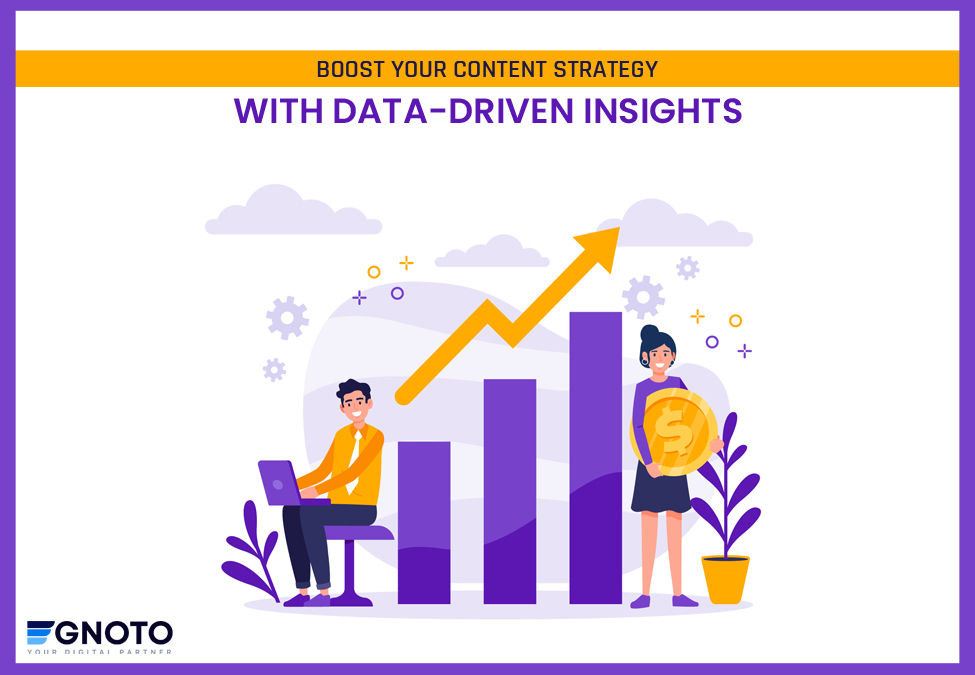Many top marketers believe data-driven marketing is the future of marketing. However, using data insights for marketing is not new because data is everywhere; it has been here for a long time. Then why is there so much buzz around using data?
Nowadays, data-driven insights have streamlined the ways for businesses and their content marketers. With the help of software, they can collect a vast amount of data, clean it, and process it in seconds, which was unachievable a few years back. Many giants like Amazon, Uber, DoorDash, and Viking Steel Structures know what you want to buy, where you want to travel, what you want to eat, and where you want to live more than you.
How? They have a tremendous amount of data about their customers. Amazon servers handle around 100 petabytes of data daily. The company uses this data to improve customer experiences, create better marketing strategies, personalize product recommendations, and improve overall operational efficiency.
Many other small and large companies have also improved their content marketing strategies and gained profit through data-driven insights. You can also be ahead of the curve by optimizing your content marketing efforts with the help of data analysis.
What Are Data-driven Insights?
Data-driven insights are the results derived from analyzing a large amount of data. Patterns are checked in the data and analyzed for predictions. Data-driven insights can vary for businesses because insights depend on the type of data fed to the software.
For example, you can forecast customer needs in the real estate business by analyzing the industry’s last twenty years of data. Data will show patterns in customer buying behavior and interest. After studying these insights, you can predict what type of property or building will be in demand in 2024 and beyond. This information allows you to create better marketing strategies for your real estate business.
Top 7 Benefits of Using Data-driven Insights for Content Marketing
How effective is data-driven insight for businesses? What can they achieve with it? Let’s find the answers to all your questions below.
- You Can Reach the Right People:
Not everyone wants to buy everything, so you have to find people who want to use your services. Data analysis software helps you identify a target audience. It segments customers based on their buying behavior and purchase history. Moreover, predictive analytics help you find potential customers.
- You Can Identify Customer Pain Points:
Customers’ feedback and reviews about the product help identify the type of services and products they want. If many customer bases point towards one issue, it must be resolved. Data-driven insights help you improve customer experience and content strategies to retarget them.
- You Can Make Informed Decisions:
Data-driven insights analyze a vast amount of data. When you consider these insights when making a decision, you increase the chances of its success. You will not need to rely only on intuition and current market trends to decide the next marketing move. You can collect, clean, and see patterns in the data to make a fruitful decision.
- You Can Create Personalized Messages:
Crafting personalized messages for content marketing plays a crucial role. Since businesses have a lot of data about their customers’ needs, interests, buying behavior, preferences, and demographics, they can easily create personalized messages. It helps them attract more customers and achieve revenue goals. So you can exceed your revenue goals using data insights for personalized marketing.
- You Can Optimize Marketing Spend (ROI):
40% of brands plan to increase their data-driven marketing budget (Inves) because it helps increase ROI. Data-driven marketing helps businesses achieve 5-8 times higher ROI than those that don’t use data. Understanding customer preferences helps make better decisions about marketing strategies that drive results.
- You Can Ensure Better Customer Retention:
Data insights into customer behavior, buying patterns, preferences, interests, and pain points help you understand what customers want. This, in turn, allows you to offer them improved services, leading to customer retention. Moreover, data analysis allows you to identify trends and tailor customized experiences. It leads to customer satisfaction, which is crucial for retaining them.
- You Can Forecast Future Trends:
An increasing number of competitors saturate market opportunities. However, you can be ahead of your competitors by forecasting demand and finding ways to meet it. Data-driven insights help you predict future trends to prepare to meet them before your competitors. You can also analyze which content marketing type will suit a particular trend. Additionally, it helps you prepare for seasonal highs and lows.
How to Use Data-driven Insights for Content Marketing?
Which platform is the best for video content marketing? How will you find out about it? By researching and analyzing data about top video streaming platforms and audience volume on the platform, correct?
Similarly, you can analyze data for different marketing purposes. In the space below, we have streamlined the ways to use data-driven insights for content marketing. Let’s check out.
- Predict Customer Behavior:
Advanced analytics tools and machine learning algorithms are used to develop predictive models that forecast trends. These models consider customer buying behavior and patterns to discover possible future trends. By understanding what your customers will purchase, you can create a better content strategy and target these customers accordingly. But before that, ensure the data is relevant and clean to avoid misleading decisions.
Here are some questions for prediction:
- What trends are emerging in our industry?
- Which products have shown consistent growth?
- Which customer segment is more likely to respond to a new product launch
- Analyse High-performing Content:
Which type of content is performing better? Is this an infographic, video, blog, interview, or social media post? With the help of data-driven insights, you can find the most suitable content type for your marketing goals. You can track metrics like views, shares, and comments on the different types of content and understand which shows high engagement and which does not.
Moreover, demographic data can help determine who interacts with your content. Interaction with different headlines, images, and videos can also indicate what is working and what is not.
- What are the demographics of the audience interacting with this content?
- What topics are trending for video content and social media posts?
- What channels drive the most traffic to infographics?
- Identify Content Gap:
With content gap analysis, you can find problems with low CTR on your content. Many times, missing content pieces affect the engagement rate. It includes outdated information, keyword fluctuation, and customer interest shifts. So, if you don’t analyze the content gap, you cannot keep up with what customers want now.
With data-driven insights, you can learn about missed opportunities and potential opportunities. Now, you can prioritize which content can increase reach and improve the business’s visibility. This information helps you make informed decisions about creating an effective marketing campaign.
- What topics are competitors covering?
- What topics have I yet to cover for content marketing?
- What is the performance of particular content on different platforms?
- Monitor Trends:
“Do you sell almost the same number of products at a particular time of year? And are the same number of products sold in the gap of 2 years? You have observed this through a decade-old data set. It clearly is a pattern that repeats over time within 10 years.” Data-driven insights make businesses aware of various patterns that help them make crucial content marketing decisions.
You can use tools to monitor trends and save your time. Tools use massive data and machine learning algorithms to show patterns clearly and accurately.
Have a look at the image below. It presents the volume of information created, captured, copied, and consumed globally from 2010 to 2020, with data forecasted from 2021 to 2025.
- Conduct A/B Testing:
Through A/B testing, you can analyze which version of your marketing campaign performs well. This type of testing becomes easy with data-driven insights, which provide insights into customer behavior, preferences, and interests. It allows for better resonating with customer needs and business values before creating content.
So businesses can easily find key performance indicators and measure the success of different marketing campaigns. Likewise, statistical analysis helps them quickly determine the importance of various campaigns.
- How much data is needed for extensive A/B testing?
- How long should I run the particular test?
- Analyse Competitors:
Competitor analysis is vital for creating a successful content marketing strategy. Data-driven insights, which use a tremendous amount of data, make this process easy. With the help of data analysis, you can brainstorm better marketing opportunities and improve the visibility of your website and business. Many data analysis models show what competitors followed before and what they are following now for marketing.
With this information, you can create a better marketing strategy for your business. Well, this is the last step of using data-driven insights, but it has nothing to do with sequence. That is also fine if you feel like doing competitor analysis at first.
- What are competitors doing for more engagement?
- How do the content strategies of competitors differ from yours?
- What tools and platforms do competitors use to create marketing strategies?
Challenges to Using Data-driven Insights for Content Marketing
Data-driven insights benefit content marketers in many ways, but only when insights are correctly utilized. Often, marketers make some mistakes and end up creating ineffective marketing strategies.
Here is the list of common challenges marketers face while using data-driven insights.
One common challenge is data collection, Cleaning, and Processing. Where is data available? How do I get this data? And how can I remove redundancies or clean the data? Businesses often can’t get over this problem or waste most of their time resolving it.
Now comes other crucial challenges:
- Lack of Quality Data:
Not all information is valuable, and not all data is informative. Low-quality data or irrelevant data can lead to misleading insights. It’s essential to ensure the quality of data before considering it.
- Data Storage:
Amazon, Google, Uber, Netflix, and other giant companies have enough budget and platforms to store data. However, small companies lack proper data storage systems and budgets. So, data storage is a big challenge in data analysis.
- Data Privacy and Safety:
People have become more aware of data safety than ever, so collecting their information is no longer easily accessible. You often have to go through complex legal requirements to use customer data and personal details.
- Skills to Use Data:
Having access to data is one thing; using it effectively and interpreting it is another. Often, you need to gain the skills to use data and get insights from it. In this case, you must spend time learning skills and knowledge.
- Dynamic Market:
Consumer preferences and industry trends are changing rapidly. Keeping up with the pace often proves exhausting because you must constantly update your data analysis strategies to match dynamic market needs.
Final Thought
Data is a new currency! This term is becoming popular because businesses have started considering data for even tiny decisions. From market research to content creation and performance analysis, data-driven insights are omnipresent. You can create successful marketing campaigns utilizing the power of data analysis. Likewise, leading the pack will become easier by forecasting demands. Well, you will also have to face some challenges while leveraging data-driven insights, but this is part of the process.










